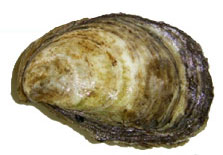Fact Sheet: Aquaculture Oysters
Appearance

Scientific Name
Crassostrea virginicaMarket Forms
Live in shell, fresh shucked (in pints, quarts or gallons), frozen (breaded and unbreaded) and frozen half shell.Marketing
History has proven that the salinity levels of Virginia waters (the mixture of fresh water from the Appalachian Mountain Range, mixing with the Atlantic Ocean) makes the taste of Virginia oysters superior to other states. Virginia's location also gives our oysters moderate winters and cool summers, which helps Virginia oysters and extends their growing season.Size
Market size is approximately 3 inches for oysters in the shell. Shucked oysters are designated according to size ranging from the largest “counts” to smallest “standards.”small . . . . . . . . . . over 500 meats/gallon
standard . . . . . . . 301 to 500 meats/gallon
select . . . . . . . . . 211 to 300 meats/gallon
extra select . . . . . 160 to 210 meats/gallon
count . . . . . . . . . under 160 meats/gallon
